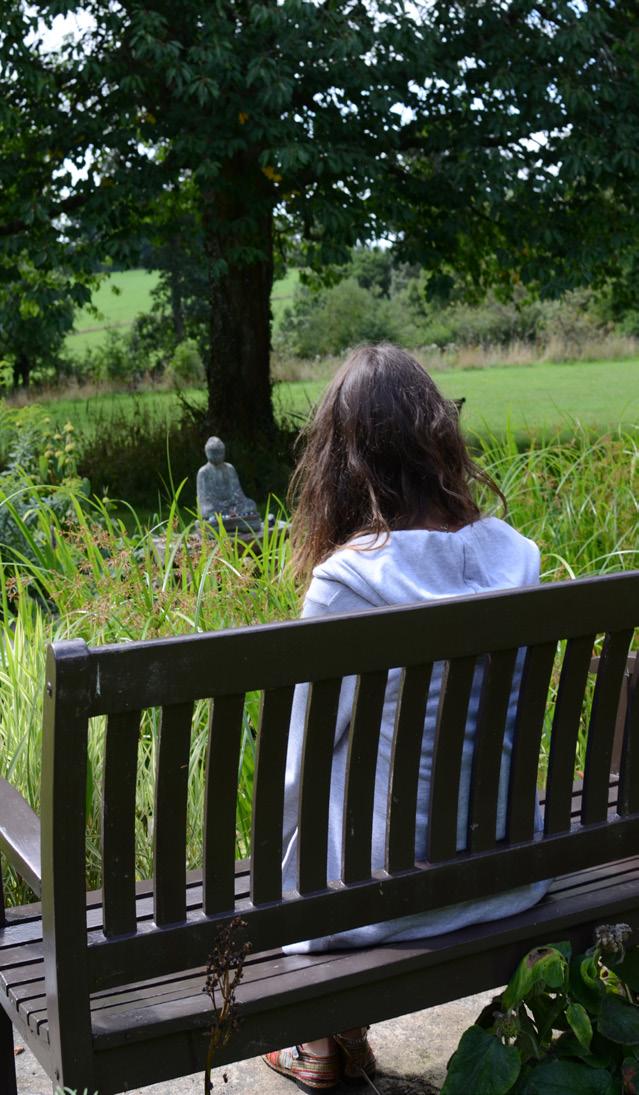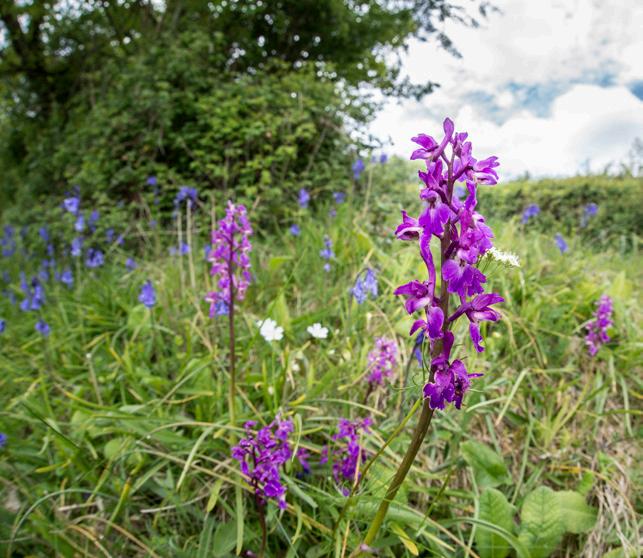
9 minute read
LIVING MADE SIMPLE
IF I was writing this with book-sized word-counts in mind, this ‘chapter’ would include religion, drugs and addictions (the popular narcotics of choice, plus the less obvious but more common examples like consumerism and social media) and a wide range of personal development, therapies, etc. Maybe with a strapline something like ‘Mid-altering substances and practices’… But I actually only have around 1000 words, so instead I will concentrate on something I believe has virtually infinite potential for personal and societal development - meditation. And to keep it all within the target wordage, I intend to apply my recently developed ‘What You Need To Know’ principle. (You will also find it applied - and more fully explained - over the page in this online issue where I write about keeping poultry). While a great deal can be said about meditation (read the books, trawl the websites, experience the workshops) the core principle is actually very simple and can be enjoyed by everyone. I believe it’s a natural, primal function - and that we simply need to remember, or rediscover, how to do it. I see the act of meditation as being a return to how we are naturally; the ‘self’ we were before life threw all kinds of shit at us. Us without all the worries and doubts and communication and preoccupations that busy up our lives. Meditation takes us back to a personal ground zero that’s a place of peace and contentment. I’ve heard meditation described as a kind of personal reboot. But if we’re staying with the computer analogy, it’s more like a return to factory settings. There’s one other very important principle we need to establish. That peaceful state of mind, like this whole (and I mean ‘whole’) simpler way of being and living, is simple - but it’s not necessarily easy. Think of meditation as being very like a physical exercise - running, for example. It will feel difficult at first, but it will get easier with practice; the more you do it, the more benefit you’ll get; and you will eventually experience its rich rewards in other parts of your life. Also like running, it really helps if you do it regularly so it becomes part of a routine and, ultimately, a habit. Do everything you can to remove any barriers to meditating regularly. Try to sit: at a regular time of day (generally the mornings are best - feeling sleepy is a real problem for beginners); for a fixed period of time (30 minute is good - use your phone timer); and ideally in the same place - somewhere that’s always free and private at that time. More difficult for people with young children, I realise. Like I said, ‘simple, but not easy…’ And so to the practise itself… Your aim is to become totally relaxed physically, with a clear mind. So, let’s sort the physical stuff first. Meditation technique is all about the breath – we do it automatically anyway, it’s rhythmic and it literally energises the body. Sit upright, but comfortably and relaxed: imagine a string attached to the top of your head, gently pulling you upwards (you can sit crosslegged on the floor if you Are you sitting comfortably? MARTIN FOSTER continues his quest for a simpler and more sustainable way of living. Having looked at the practice and theory, he’s this time taking a more inward journey - but argues it’s actually the most fundamental and down-to-earth subject of them all…
prefer - I always sit on an upright dining chair). Rest your hands in your lap. Start with five deep breaths in through the nose and out through the mouth – count to five on the in-breath and five on the out-breath. Then, on your next (deliberate, but ‘normal’) breath, concentrate on the sensation of the breath coming in through your nostrils; and as you breathe out (normally, also through your nostrils), imagine your feet relaxing… almost melting into the floor. On your next breath, again concentrate on the air entering through your nostrils and on the outbreath, imagine your lower legs relaxing. Next, notice incoming air in your nostrils and on the out-breath relax your thighs. Repeat this process with all your body: lower arms; upper arms; your lower torso (let your belly go soft) and your upper torso (left your shoulders drop down – but keep your back straight). Finally, relax your face, letting your jaw drop. Take half a dozen breaths, concentrating on how the inbreath feels in your nostrils – and notice on the out-breaths how your whole body feels relaxed. It’s now time to clear your mind. And this is the reason most people who’ve tried it say they can’t meditate. ‘I can’t stop thinking,’ they say. Or ‘I just keep having new thoughts…’ That’s fine. You will. Everyone does. As you gradually dump some of life’s mental debris, it leaves space for memories to resurface. For new ideas to be born. This is a good thing. That’s just your mind doing what it wants to, rather than what the world tells it to do. Don’t try to ‘block out’ your thoughts. You can’t. Instead, acknowledge each thought and then let it go. You can act on them later if you need to – this is not the time. This is the one time you have NOT to think. If you catch your thoughts drifting, notice your breath coming in and as you breathe out, let your thoughts go with it. If it helps, you could imagine the breath entering your head through your nose, swirling around
Advertisement

your head, gathering up your thoughts and taking them away on the out-breath. Even if you realise you’ve been thinking for ages, don’t worry, it doesn’t matter. Enjoy the realisation that right NOW you are back in the moment. Drifting is inevitable – but that you have noticed it, and that you are back in the moment, is something to celebrate. Clearing your mind really is the trickiest bit but you will get there. It’s like developing a new muscle. It will take time and practice. No-one decides to start running and immediately plunges into a 10k stormer… Right, now we’re going to the next stage. Some might think of this as ‘going deeper’. This bit will be really tricky until you’ve been able to truly relax your body and at least start to calm your mind, so don’t worry if you can’t do this straight away. Maybe not even in the first week. Just stick at it. It’s going to be worth the effort - I promise! And lo, you are meditating! I can see that my apparent dismissal of other techniques, methods and practices sounds like it’s somewhere on the spectrum between ‘rude’ and ‘dismissive’. I truly mean no offence. Perhaps my stripped-down form won’t take you to the higher state of consciousness and enlightenment for which some strive, but it’s simple, free, universally achievable and can be truly life-changing. Martin

Iabsolutely Love hedgerows, and when Scott invited me to write something about this for Reconnect, I thought; “Why not?...share the love!”.
Hedgerows are so much more than just the boundaries that ‘hedge in’ the fields. It’s so easy to just blip past them in our cars on the way from A to B without really noticing what marvels they contain, but I’d really recommend slowing down and really paying attention to these treasures around us. ‘Hedgerow rambling’ is of my very favourite pastimes. In fact, during the restricted movement time of the Covid-19 lockdown, I have found myself appreciating and being ‘resourced’ by this simple pastime more than ever. I’ve come to think of it almost as a kind of daily mindfulness activity. All the stresses and mental pre-occupations of the day just drop away for a while whilst I wander along and get ‘lost’ in the hedge. Sometimes I might pick myself a delicious hedgerow salad with Hedge Garlic, Wild Ransoms and young hawthorn leaves, or whatever other edible delights I find. Sometimes I find a plant or a type of Bee I don’t recognise, so I pay close attention to its appearance, then look it up in one of my identification guides. At other times I get out my camera and try to make some kind of art out of this inspiration. It’s an endless source of fascination that changes everyday as different plants grow into season. I’ve realised that I have a kind of ‘hedgerow calendar’ in my head, where I mark the passage of time in terms of which plants are out when. I call the first two weeks of May, for instance, the time of the ‘Mayflower Power’, when the hawthorn blossoms (known in folklore as ‘Mayflowers’) light up the lush green of spring with their brilliant white floral explosions, accompanied by a symphony of colour from bluebells, pink campion, red valerian, yellow archangel and so much more. It’s such a joy to behold. The more I think about it, the more I think that the hedgerows of Devon might just be one of our greatest treasures - Devon has over 33,000 miles of hedges. That’s enough hedgerows to go all the way around the world and about a third as much again! Over three-quarters of these hedgebanks are thought to be of at least medieval origin (AD 1150 – 1450). In ecological terms, hedgerows are invaluable wildlife corridors, made particularly rich in diversity by their ability to offer a home to many woodland species in their shady interiors and the ideal conditions for sun loving woodland edge species on their exterior edges, as well as a welcome refuge for many meadow plants from the plough or from the grazing livestock in the fields. Apparently, one member of the Devon Hedge Group surveyed an 85m stretch of hedge over two years and recorded 2,070 species living within. Supposing that was at least moderately typical biodiversity for a Devon hedge, just think how much life those 33,000 miles of hedgerow are supporting! Throughout history, hedgerows have been, and still are, incredibly important for people too, as a source of food, firewood and herbal medicine for instance. They are playing a vital role in helping us draw down carbon to combat climate change and in helping us manage soil erosion and water storage. If you’d like to find out more about hedgerows yourself, I’d say the first thing to do is simply to get out there and start exploring them! Maybe download a plant ID app like PlantSnap, or take an identification guide. Take a camera too maybe. You can also find out more online at https:// devonhedges.org or hedgelink.org.uk, or you could even check out my ‘Postcards from the Hedge’ videos on youtube on the Be BuckfastleighTV channel, and my photographs on my website at www. chrissmithphotographic.com/ Postcards-From-The-Hedge.php Life on the Hedge by Chris Smith


WILD CAMPS FOR 11-16 YEAR OLDS NEAR BRISTOL: HUNGER GAMES AUGUST 20 - 24 MOCKINGJAY AUGUST 26 - 30


wildwisehungergames.co.uk • 01803 868269












